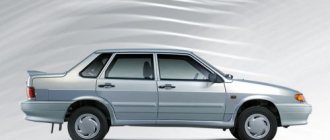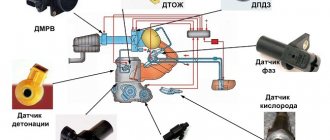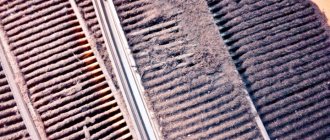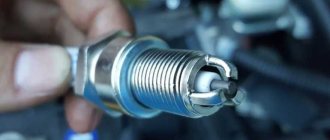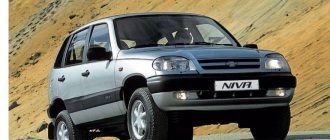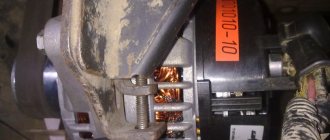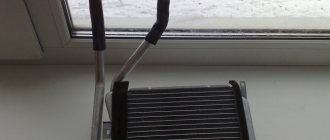Review of faults and methods for repairing them
GAZelle
fuel in mixed cycle, city-highway.
consumption
in the city: Website: ... GAZelle fuel consumption, in the city
Consumption
The simplest way to calculate how much fuel a car spends per 100 km requires the driver to fill the gas tank completely, then drive a short distance and look at the result. After this, the calculation is carried out using the simplest formula Рт = L/Km x 100, which stands for:
Fuel consumption per 100 km = Volume of fuel burned (in liters) / Distance traveled (in km) x 100
This option is simple but effective: it allows you to obtain up-to-date data on the rate of diesel fuel consumption. Unfortunately, this somewhat limits the accuracy of the method, since no additional parameters are taken into account.
You can also calculate fuel consumption using the standard formula Qn = 0.01 x Hs x S x (1 + 0.01 x D), where Qn is the standard consumption in liters; Hs – base consumption in liters per 100 km, declared by the manufacturer; S is the current mileage, and D is a clarifying factor (it can either decrease or increase the result).
The coefficient is selected according to the following rules:
- Air conditioning or climate control system – plus 7%;
- Operation within urban areas (from 250 thousand inhabitants) – plus 15%;
- After 100 thousand kilometers and 5 years of operation - plus 5%;
- Check regulations for your region. Depending on the climate, up to 20% can be added.
To calculate fuel consumption as accurately as possible, a calculator is much better. Knowing the number of kilometers traveled and the volume of gasoline consumed, you can get accurate consumption figures without resorting to independent calculations.
The obtained data can be used for several purposes:
- Expense planning. If you usually only use your car for intracity trips, then it makes sense to calculate your gas mileage before going on a long trip. Using an online fuel calculator, you can get even more accurate data, including the cost of a liter of gasoline.
- Preventing unpleasant situations. An experienced motorist often finds himself in a situation where he needs to get somewhere urgently and does not want to waste time refueling. Knowing the gasoline consumption per 100 km, you can estimate whether you can reach the nearest gas station with the liters remaining in the gas tank.
- Diagnostics. Checking the rate of fuel consumption should be carried out at least once every six months. The obtained data should be compared with the basic indicators declared by the manufacturer. A large difference in the data obtained may indicate a malfunction.
Basic indicators are the standard that a machine meets after it leaves the assembly line. To find out the fuel consumption standards for your car model, check out the table.
Fuel consumption: standards, statistics and reviews
Not the best engineering solution for low-cost cars, as it contains a number of complex engineering solutions, such as a modified carburetor and an improved crankshaft. The engine is powerful, and in terms of fuel consumption the situation is not the same as with the 24th and 29th Volgas; my gasoline consumption was 13-14 liters in the city and about 9 liters on the highway, but that’s if you drive quietly.
Transmission
If the driver continued to operate the car, despite the twitching that appeared when pressing the clutch, which is exactly how the defect should manifest itself, the seat for the washers on the crankshaft and on the cylinder block was broken. Failure to comply with the above measures can have a detrimental effect on engine performance, ranging from an unreasonable drop in power to an increase in fuel and lubricant consumption.
Technical characteristics of ZMZ 406 2.3 l/100 l. With. Engine ZMZ-406
If the machine is actively used, then all costs for purchasing and installing the system will pay off in about a year and savings will begin, not to mention the fact that the engine life when working on a propane-butane mixture will be higher, and the risk of emergency situations with the engine that resulted will be reduced. would incur additional costs. Most likely, the former owner-injector operator actually doesn’t know anything other than pressing the buttons of diagnostic scanner-testers, uploading programs into blocks and telling fairy tales.
Operation of a Gazelle with a 406 gas engine • ZMZ-406 engine
| Gasoline consumption per 100 km gazelle engine 406 injector If you look at the model range of domestic automobile companies, you can come to the conclusion that minivans are not a priority direction in the development of mechanical engineering. The question of how to reduce fuel consumption on a Gazelle is asked mainly by business owners, for whom the payback of the business and the amount of profit depend on the amount of gasoline consumed. |
- Intensity of air conditioner use. In extreme weather conditions it is necessary. But if the air conditioner is constantly on, then the calculator will show more and more gasoline consumption with each trip.
- Open windows. If you ventilate too often, the fuel will burn faster - all due to reduced aerodynamic performance.
- Engine condition. A cold engine is not only a time saver, but also a sure way to start spending more on gasoline.
- Vehicle weight. It would seem that this indicator should remain unchanged. But in practice, car enthusiasts often fill their cars with unnecessary but heavy rubbish.
- Tire pressure. As soon as it starts to differ from the “tabular” indicators, pump it up. Does not pump up - replace immediately.
Design of the ZMZ-406 engine • Ulyanovsk UMZ-4216 engines with a volume of 3 liters are also installed on the new Gazelles.
Table of fuel costs for Chrysler brands. Modification with carburetor
Although, if in hot weather you close the windows and use air conditioning, then using the latter increases fuel consumption by more than fifteen percent. The dead Arzamas MAF-P and the phase sensor, after replacing it, I realized that it is not the sensor itself, but the contact in the chip. It is worth the HBO cotton in the intake manifold, almost always a bad MAF.
| hoopoe |
| View profile |
| Send a private message to hoopoe |
| Find more posts by hoopoe |
| mindforms |
| View profile |
| Find more posts by mindforms |
| Punisher |
| View profile |
| Send a private message to Punisher |
| Find more posts by Punisher |
| 78 RUS |
| View profile |
| Send a private message to 78 RUS |
| Find more posts by 78 RUS |
| Read the diary |
ZMZ engines for Gazelle
ZMZ produces most of the engines that are installed on Gazelle cars of various models. Let's consider the most popular of them, namely models 402, 405, 406 and 409.
ZMZ-402 is a modification of the GAZ-24D engine. The main components, as well as elements of the power unit, have been improved. This is a 4-cylinder carburetor engine with a volume of 2.5 liters. Its fuel consumption is 13.5 l/100 km in the urban cycle.
Among the modifications of the ZMZ-402 engine are:
- ZMZ-4021.1 - mainly used on off-road vehicles produced by GAZ and UAZ.
- ZMZ-4025.1 is a carburetor gasoline engine with valves located in the upper part of the cylinder head.
- ZMZ-4026.1 is a model with a carburetor, in the upper part of which there are exhaust and intake valves (can be found on some GAZ minibuses).
The latest modification of the 402 engine complies with the Euro-4 standard.
Operating principles of an injection engine
An injector is a special system for injecting fuel into a car engine. Unlike the operating system of a carburetor engine, here fuel is forcibly injected into the cylinder using injectors. Because of these features, cars with such systems are called injection.
When the engine is in working condition, the controller receives information about such indicators as:
- crankshaft position and speed;
- antifreeze temperature;
- vehicle speed;
- all uneven road surfaces;
- presence of malfunctions in the motor.
As a result of analyzing all received data, the controller controls the following systems and mechanisms:
- gasoline pump;
- ignition system;
- diagnostic system;
- fan of the system, which is responsible for cooling the car.
Because the system is controlled by software, injection parameters change instantly, allowing many functions and data to be taken into account.
Characteristics of the UMZ 4216 power plant ZMZ-402 engine
| Fuel consumption per 100 km GAZelle: Next, 2705, Sobol 2217, 2752, 3302 The model is popularly better known as Sobol Barguzin, the design of the engineers of the Gorky Automobile Plant received this name in honor of the powerful winds of Lake Baikal. Later, ZMZ-405, UMZ-4216 and Chrysler engines began to be used, characterized by improved technical characteristics and reduced fuel consumption. |
- ZMZ-4052.10;
- ZMZ-40522.10;
- ZMZ-40524;
- ZMZ-40525;
- ZMZ-4054.10.
The path from 402 to 406 • The fuel consumption rate of GAZ 31105 on the highway is 12.5 liters.
Chassis
GAZ-2752 “Sable” is, among motorists, a standard car from the “sable” family. The vehicle is equipped with special rear hinged doors, as well as a sliding side door. Technically, the declared useful volume is a total of 6.86 cubic meters for the three-seat cargo version, and 3.7 cubic meters for the seven-seat passenger version. With the introduction of body glazing and the subsequent addition of passenger seats, the car acquires the ability to simultaneously transport up to 10 people.
Engine ZMZ 409: Engine ZMZ-406
Because if you use materials of lower quality and not intended for this type of engine, the engine will quickly fail. 1 drain plug; 2 oil sump; 3 exhaust manifold; 4 engine support bracket; 5 coolant drain valve; 6 water pump; 7 coolant overheating lamp sensor; 8 coolant temperature indicator sensor; 9 temperature sensor; 10 thermostat; 11 sensor for emergency oil pressure lamp; 12 oil pressure indicator sensor; 13 crankcase ventilation hose; 14 oil level indicator; 15 ignition coil; 16 phase sensor; 17 heat insulation screen.
Cabin and platform of the GAZ-2310 car
| Cabin | Metal, two-door, three-seater |
| Platform | Metal, with folding rear and side sides; equipped with an awning |
| overall dimensions of the platform (internal), mm: | |
| length | 2340 |
| width | 1978 |
| height | 400 |
| Oil pressure, kPa (kgf/cm2) on a warm engine at idle speed: | 127 (1,3) |
| Gap between rocker arms and valves on a cold engine at 15–20° C, mm | |
| – for exhaust valves of cylinders 1 and 4 | 127 (1,3) |
| – for other valves | 0,35–04 |
| Normal liquid temperature in the cooling system, °C | 80–105 |
| Minimum crankshaft rotation speed in idle mode, rpm: | 800–850 |
| Gap between spark plug electrodes, mm | 0,7–0,85 |
| Fan belt deflection when pressed with a force of 4 daN (4 kgf), mm | 7–9 |
| Deflection of the water pump and generator belt when pressed with a force of 4 daN (4 kgf), mm | 8–10 |
| Deflection of the power steering pump belt when pressed with a force of 4 daN (4 kgf), mm | 6–10 |
| Clutch pedal free play, mm | 7–15 |
| Clutch slave cylinder rod stroke | 18–20,5 |
| Free travel of the brake pedal when the engine is not running (1), mm | 3–5 |
| Total steering wheel play,° | According to GOST R 51709–2001 |
| Minimum permissible friction layer thickness, mm: | |
| – front disc brake pads | 3,0 |
| – rear drum brake linings | 1,0 |
| The slope at which a vehicle with a full load is held by the parking brake is not less than, % | 16 |
| Installation of (2) front wheels: | |
| – caster (longitudinal inclination of the steering axis of the wheels) | +4°30’±1° (+3°±1°) (3) |
| – difference in the angles of the left and right wheels when adjusting caster, no more | 0°30′ |
| – wheel camber | 0°30’±30′ (+1°±30′) (3) |
| – difference in the angles of the left and right wheels when adjusting the camber, no more | 0°30′ |
| – wheel toe-in (each wheel to the longitudinal axis of the vehicle) | from +0°03′ to +0°10′ (from+0°01'to +0°08′) (3) |
| Installation angles (4) of the front wheels: | |
| – camber (5) | 1o |
| – lateral inclination of the kingpin | 8o |
| – longitudinal inclination of the kingpin | 4o |
| – wheel toe-in, mm | 0–3 |
| Air pressure in tires of 4×2 type cars, kPa (kgf/cm 2): | |
| – front wheels | 260+10 (2.7+0.1) – for auto. GAZ-2217 and mod. 320+10 (3.3+0.1) – for GAZ-2310, GAZ-2752 with tires 185/75 R16C 250+10 (2.6+0.1) – for GAZ-2310, GAZ-2752 with tires 215/65 R15 |
| – rear wheels | 270+10 (2.8+0.1) – for auto. GAZ-2217 and mod. for 6 passenger seats 300+10 (3.1+0.1) – for cars. GAZ-2217 and mod. For 10 passenger seats 380+10 (3.9+0.1) – for GAZ-2310, GAZ-2752 with tires 185/75 R16C 290+10 (3.0+0.1) – for GAZ-2310, GAZ -2752 with 215/65 R16 tires |
| Air pressure in tires of 4×4 type cars, kPa (kgf/cm 2): | |
| – front wheels | 240+10 (2,5+0,1) |
| – rear wheels | 240+10 (2,5+0,1) |
Fuel consumption per 100 km for Peugeot 405, Station wagon, Sedan, 1st generation... ZMZ engines for gazelle
| Gazelle Business fuel consumption per 100 km The power plant was very popular because it had a number of advantages: it tolerated low-quality fuel well, started at sub-zero temperatures, the GAZ engine was playful and economical with a high efficiency. It is necessary to take into account the following feature: the fuel consumption rate specified by the manufacturer was established during testing of the car in ideal conditions. |
| Peugeot 405 fuel consumption per 100 km owner reviews | official website If the speed of the Gazelle corresponds to the acceptable parameters, then the problem of increasing the number of liters of gasoline, diesel or gas used can be avoided. Untimely replacement of the belt and roller can lead to breakage and deformation and bending of the valves, which will entail not only expensive repairs, but also the replacement of the cylinder head. |
- age of the Gazelle car;
- natural heating of the engine;
- condition of tires.
Re: Gazelle 405 Mikas 7.1 high fuel consumption • But the 405 engine should be serviced every 10,000-11,000 km on gasoline to increase its service life.
Tuning
Many car enthusiasts wanted to take advantage of the tuning opportunity. Thus, the 405 engine was subject to modifications. Let's look at what can be done to modernize:
- Replacing the cylinder head. Of course, it will be difficult to find one, but the JP company has developed a similar cylinder head for tuning, which can be installed instead of the standard one.
- Injector (engine 405). A complete replacement of the injection system will increase the power a little, but at the same time the fuel consumption will be within 15 l/100 km, and not every owner will like this.
- Replacement of the exhaust manifold and exhaust system. Of course, you can replace the entire system, but it is worth making an accurate calculation for this improvement.
- Piston boring. A lengthy process and not always effective. Increasing the piston size from 95.5 to 98 mm will add 20%.
All these improvements reduce the engine's service life by 30%, which, accordingly, will lead to an early major overhaul. Professional racers advise carrying out such operations in a tuning studio, where specialists will make all the calculations and improve the performance of the engine without compromising the condition or loss of service life.
The fuel consumption of the Gazelle 405 (injector) depends primarily, of course, on the quality of the fuel itself. Below we will consider the factors influencing fuel consumption, how they affect the amount of fuel consumed, how it will be possible to reduce large consumption rates, and what type of fuel is most profitable to use on a Gazelle.
Diesel or gasoline
Common malfunctions and operation. I would like to add that in a rainstorm, if the car is parked even slightly with the front end up, the engine compartment floods. Water enters the candle wells through the plugs and floods the candles. The electromagnetic clutch must be immediately replaced with an electric fan. Fortunately this is easy to do. The plastic valve cover must be replaced with a metal one. Very picky about the quality of oil and filters. On ordinary Lukoil oil the service life is about 150 t.km. I have been using Q8 10W40 from day one, mileage 275,000 km in 13 years.
Fuel consumption of GAZelle Business according to owner reviews
Please note that the amount of fuel consumed by a vehicle may vary up or down as the van is loaded. At the same time, the company produces GAZelle in various body styles - “farmer”, combi, three-seater cabin, van, minibus with a high roof. All these modifications are characterized by deviations from the norm of fuel consumption. What is the actual fuel consumption of GAZelle Business? Reviews from commercial vehicle owners will tell you about this.
- Eldar, Volzhsk. At one point I decided that in addition to my main job, it wouldn’t be superfluous to have a part-time job driving my own car. For this purpose, I purchased our 2013 Gazelle Business with a 2.9-liter UMZ-4216.10 engine. What can I say about this car? For the money, this is a fairly high-quality vehicle; I personally have no complaints about GAZ over 5 years of operation. The car has an all-metal body, and as for fuel consumption, the figure increases as the vehicle is loaded. With a load of 500-600 kg, approximately 14-15 liters per 100 km in the city, that is, in fact, it is impossible to achieve the declared 12.5 liters. On the highway, the average output is 11-11.5 liters at an average speed of 90-100 km/h.
- Georgy, Moscow. I needed a truck in 2012. At that time I had a limited budget, so the question of what to choose from was the last thing on my mind. I decided to take a product from the domestic automobile industry - since 2010, the new Gazelle Business was already available. This is where I chose. Now I have been using the car for 6 years and I am more pleased with the purchase than disappointed. I have a van-type truck with a UMZ gasoline engine. Consumption when loaded to failure (about 1.5 tons) can exceed 18 liters in the city. We're driving slowly, that's why these numbers are there. In a partially loaded state, the numbers are more optimistic - 14-16 liters.
- Matvey, Podolsk. In 2015, a GAZelle Business acquired a vehicle with an awning for transporting cargo from one city to another. I needed the car urgently, so I bought a car from a friend in good condition, but with mileage already 150 thousand km. What I didn’t like about Business was, in my opinion, the weak UMZ-4216.10 2.9-liter gasoline engine. When loaded, it doesn't pull uphill at all. Consumption in the city is 14 liters, but most often I drive on highways, which take up about 80% of the total mileage. On the highway it “eats” 11 liters, which is not so bad.
Both UMZ-4216 engines are combined with a manual gearbox; their difference comes down to compliance with different environmental standards - the first is Euro 3, and the second is Euro 4. At the same time, the level of fuel consumption is approximately the same - on average 14 liters in the city when loaded, which is 1.5 liters higher than the standard established by the manufacturer. In the suburban cycle, the car burns up to 11 liters per 100 kilometers.
Site about SUVs UAZ, GAZ, SUV, CUV, crossovers, all-terrain vehicles
If the calculation of the average operating fuel consumption of a UAZ with a ZMZ-409 engine, discussed in the previous material, showed that the consumption is very high, then it is necessary to look for the reasons and take measures to normalize it. Extremely unpleasant from the financial side, increased fuel consumption also indicates problems with the engine or its systems, which can at any time lead to a breakdown and even greater financial investments in repairs.
Increased fuel consumption, possible ways to normalize fuel consumption on the ZMZ-409 engine.
If the on-board self-diagnosis system of the engine control unit does not produce any fault codes and there are no obvious and immediately understandable reasons for increased fuel consumption, then the best solution would be to immediately contact a specialized service station for a complete check and diagnosis of the vehicle. .
However, if, of course, you have the desire and opportunity, then you can try to fix the problem yourself by carrying out or performing some simple operations and actions listed below. Perhaps they will help and you won’t have to waste your time and money.
Operating or typical parameters of the ZMZ-409 engine.
One source of information, which in some cases can help find and localize the cause of increased fuel consumption, will be the operating or typical parameters of the engine, determined in real time when it is idling. These parameters are read using an on-board computer or scanner tester. For example, for ZMZ-409 of Euro-2 environmental class they are like this.
And another parameter that should be taken into account is fuel consumption in idle mode. For a warm ZMZ-409 engine, its normal values are in the range of 1.3-1.5 liters per hour. Also determined using an on-board computer or scanner tester. If the value is above 1.5 l/hour, then this indirectly indicates a malfunction in the fuel injection system or engine management system.
Electronic engine control unit.
Due to various deviations in characteristics and failures of sensors and actuators of the control system, the control unit accumulates false adaptive data (self-learning parameters), which can ultimately lead to deterioration in engine performance, including causing increased fuel consumption. Therefore, you can try resetting these adaptation parameters. This operation often leads to the restoration of normal engine functioning.
For the ZMZ-409 Euro-2 engine.
The self-learning parameters of the control unit can be reset by disconnecting the battery for more than two minutes. After connecting the battery, in order for the control system to self-learn, it is necessary to warm up the engine to operating temperature, let it idle, and then for one to two hours allow the vehicle to move at partial loads with moderate acceleration until its normal operating performance is restored.
For the ZMZ-409 Euro-3 engine and higher.
When the battery is disconnected, the self-learning parameters of the control unit are not lost; they can only be forcibly reset using a scanner tester. Repeated self-learning of the control unit may require several hours of engine operation in various modes.
Oxygen sensor or lambda probe.
The engine control unit regulates the composition of the air-fuel mixture mainly based on signals from the oxygen sensor, and accordingly, the average fuel consumption of the vehicle directly depends on the serviceability and condition of this sensor.
Possible reasons for incorrect operation of the oxygen sensor.
- the tip of the sensor with the sensitive element, located in an aggressive exhaust gas environment, may partially melt or become clogged - the sensor may not work correctly if the composition of the exhaust gases is not standard, for example, contains excess engine oil vapor - the sensor has lost activity and requires replacement, as it is at its limit your sensitivity
Moreover, these reasons will not necessarily be recorded by the on-board self-diagnosis system as errors. Therefore, first you can try to disconnect the sensor from the wiring harness and check whether fuel consumption will decrease or not.
If it drops, then you need to replace the oxygen sensor with a new one or eliminate the reasons for its incorrect operation. For example, oil getting into the engine cylinders can be externally determined by the blue exhaust. An extended check of the health of the oxygen sensor is discussed in detail in a separate material.
Mass air flow sensor.
For various reasons, its characteristics may differ from the nominal ones, which leads to incorrect formation of the composition of the air-fuel mixture and, in turn, affects the operation of the lambda probe. The procedure for checking the serviceability of the mass air flow sensor is discussed in detail in a separate material.
Modifications of ZMZ Engine ZMZ-405
| Fuel consumption per 100 km | FUEL CONSUMPTION CALCULATOR per 100 km The design team, under the leadership of Vladimir Chetverikov, relied on both domestic and foreign experience when creating the GAZelle family. In 2003, the company carried out a planned restyling, during which Barguzin was not only transformed externally, but also received technologically advanced power plants. |
- 12.5 liters per 100 km in the urban cycle;
- 10.4 liters per 100 km in the extra-urban cycle;
- 11.9 liters per 100 km in the combined cycle.
PURPOSE
The GAZ 2752 gained the greatest popularity among small and medium-sized businesses, which is due to its design features and functional characteristics. The car is also in demand among public utilities, law enforcement agencies, and cash-in-transit companies.
The vehicle is used to transport cargo of various weights over short and long distances. Sobol is convenient because it is not subject to entry restrictions in large cities. GAZ 2752 minibuses are used as minibuses and tourist transport.
To drive a car, a category “B” license is sufficient.
